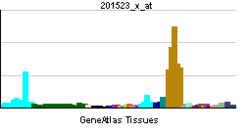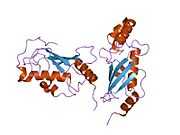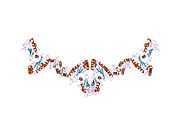UBE2N
| Ubiquitin-conjugating enzyme E2N |
|---|

PDB rendering based on 1j7d. |
| Available structures |
| PDB |
Ortholog search: PDBe, RCSB |
| List of PDB id codes |
|
1J7D, 2C2V, 3HCT, 3HCU, 3VON, 3W31, 4DHI, 4DHJ, 4DHZ, 4IP3, 4ORH
|
|
|
| Identifiers |
|---|
| Symbols | UBE2N ; HEL-S-71; UBC13; UbcH-ben; UbcH13 |
|---|
| External IDs | OMIM: 603679 MGI: 1934835 HomoloGene: 128406 ChEMBL: 6089 GeneCards: UBE2N Gene |
|---|
| EC number | 6.3.2.19 |
|---|
|
| RNA expression pattern |
|---|
|
|
|
| More reference expression data |
| Orthologs |
|---|
| Species | Human | Mouse | |
|---|
| Entrez | 7334 | 93765 | |
|---|
| Ensembl | ENSG00000177889 | ENSMUSG00000074781 | |
|---|
| UniProt | P61088 | P61089 | |
|---|
| RefSeq (mRNA) | NM_003348 | NM_080560 | |
|---|
| RefSeq (protein) | NP_003339 | NP_542127 | |
|---|
| Location (UCSC) | Chr 12:
93.8 – 93.84 Mb | Chr 10:
95.52 – 95.55 Mb | |
|---|
| PubMed search | | | |
|---|
|
Ubiquitin-conjugating enzyme E2 N is a protein that in humans is encoded by the UBE2N gene.[1][2]
Function
The modification of proteins with ubiquitin is an important cellular mechanism for targeting abnormal or short-lived proteins for degradation. Ubiquitination involves at least three classes of enzymes: ubiquitin-activating enzymes, or E1s, ubiquitin-conjugating enzymes, or E2s, and ubiquitin-protein ligases, or E3s. This gene encodes a member of the E2 ubiquitin-conjugating enzyme family. Studies in mouse suggest that this protein plays a role in DNA postreplication repair.[2]
Interactions
UBE2N has been shown to interact with:
References
- ↑ Yamaguchi T, Kim NS, Sekine S, Seino H, Osaka F, Yamao F et al. (February 1997). "Cloning and expression of cDNA encoding a human ubiquitin-conjugating enzyme similar to the Drosophila bendless gene product". J Biochem 120 (3): 494–97. doi:10.1093/oxfordjournals.jbchem.a021440. PMID 8902611.
- ↑ 2.0 2.1 "Entrez Gene: UBE2N ubiquitin-conjugating enzyme E2N (UBC13 homolog, yeast)".
- ↑ Ewart-Toland A, Briassouli P, de Koning JP, Mao JH, Yuan J, Chan F et al. (August 2003). "Identification of Stk6/STK15 as a candidate low-penetrance tumor-susceptibility gene in mouse and human". Nat. Genet. 34 (4): 403–12. doi:10.1038/ng1220. PMID 12881723.
- ↑ Unk I, Hajdú I, Fátyol K, Hurwitz J, Yoon JH, Prakash L et al. (March 2008). "Human HLTF functions as a ubiquitin ligase for proliferating cell nuclear antigen polyubiquitination". Proc. Natl. Acad. Sci. U.S.A. 105 (10): 3768–73. doi:10.1073/pnas.0800563105. PMC 2268824. PMID 18316726.
- ↑ 5.0 5.1 5.2 Deng L, Wang C, Spencer E, Yang L, Braun A, You J et al. (October 2000). "Activation of the IkappaB kinase complex by TRAF6 requires a dimeric ubiquitin-conjugating enzyme complex and a unique polyubiquitin chain". Cell 103 (2): 351–61. doi:10.1016/s0092-8674(00)00126-4. PMID 11057907.
Further reading
- Bonaldo MF, Lennon G, Soares MB (1997). "Normalization and subtraction: two approaches to facilitate gene discovery.". Genome Res. 6 (9): 791–806. doi:10.1101/gr.6.9.791. PMID 8889548.
- Hofmann RM, Pickart CM (1999). "Noncanonical MMS2-encoded ubiquitin-conjugating enzyme functions in assembly of novel polyubiquitin chains for DNA repair.". Cell 96 (5): 645–53. doi:10.1016/S0092-8674(00)80575-9. PMID 10089880.
- Deng L, Wang C, Spencer E, Yang L, Braun A, You J et al. (2000). "Activation of the IkappaB kinase complex by TRAF6 requires a dimeric ubiquitin-conjugating enzyme complex and a unique polyubiquitin chain.". Cell 103 (2): 351–61. doi:10.1016/S0092-8674(00)00126-4. PMID 11057907.
- Chan NL, Hill CP (2001). "Defining polyubiquitin chain topology.". Nat. Struct. Biol. 8 (8): 650–2. doi:10.1038/90337. PMID 11473244.
- Moraes TF, Edwards RA, McKenna S, Pastushok L, Xiao W, Glover JN et al. (2001). "Crystal structure of the human ubiquitin conjugating enzyme complex, hMms2-hUbc13.". Nat. Struct. Biol. 8 (8): 669–73. doi:10.1038/90373. PMID 11473255.
- Ashley C, Pastushok L, McKenna S, Ellison MJ, Xiao W (2002). "Roles of mouse UBC13 in DNA postreplication repair and Lys63-linked ubiquitination.". Gene 285 (1-2): 183–91. doi:10.1016/S0378-1119(02)00409-2. PMID 12039045.
- McKenna S, Moraes T, Pastushok L, Ptak C, Xiao W, Spyracopoulos L et al. (2003). "An NMR-based model of the ubiquitin-bound human ubiquitin conjugation complex Mms2.Ubc13. The structural basis for lysine 63 chain catalysis.". J. Biol. Chem. 278 (15): 13151–8. doi:10.1074/jbc.M212353200. PMID 12569095.
- Anandasabapathy N, Ford GS, Bloom D, Holness C, Paragas V, Seroogy C et al. (2003). "GRAIL: an E3 ubiquitin ligase that inhibits cytokine gene transcription is expressed in anergic CD4+ T cells.". Immunity 18 (4): 535–47. doi:10.1016/S1074-7613(03)00084-0. PMID 12705856.
- Ewart-Toland A, Briassouli P, de Koning JP, Mao JH, Yuan J, Chan F et al. (2003). "Identification of Stk6/STK15 as a candidate low-penetrance tumor-susceptibility gene in mouse and human.". Nat. Genet. 34 (4): 403–12. doi:10.1038/ng1220. PMID 12881723.
- Bothos J, Summers MK, Venere M, Scolnick DM, Halazonetis TD (2003). "The Chfr mitotic checkpoint protein functions with Ubc13-Mms2 to form Lys63-linked polyubiquitin chains.". Oncogene 22 (46): 7101–7. doi:10.1038/sj.onc.1206831. PMID 14562038.
- Zhou H, Wertz I, O'Rourke K, Ultsch M, Seshagiri S, Eby M et al. (2004). "Bcl10 activates the NF-kappaB pathway through ubiquitination of NEMO.". Nature 427 (6970): 167–71. doi:10.1038/nature02273. PMID 14695475.
- Sun L, Deng L, Ea CK, Xia ZP, Chen ZJ (2004). "The TRAF6 ubiquitin ligase and TAK1 kinase mediate IKK activation by BCL10 and MALT1 in T lymphocytes.". Mol. Cell 14 (3): 289–301. doi:10.1016/S1097-2765(04)00236-9. PMID 15125833.
- Colland F, Jacq X, Trouplin V, Mougin C, Groizeleau C, Hamburger A et al. (2004). "Functional proteomics mapping of a human signaling pathway.". Genome Res. 14 (7): 1324–32. doi:10.1101/gr.2334104. PMC 442148. PMID 15231748.
- Pastushok L, Moraes TF, Ellison MJ, Xiao W (2005). "A single Mms2 "key" residue insertion into a Ubc13 pocket determines the interface specificity of a human Lys63 ubiquitin conjugation complex.". J. Biol. Chem. 280 (18): 17891–900. doi:10.1074/jbc.M410469200. PMID 15749714.
- Takeuchi T, Yokosawa H (2005). "ISG15 modification of Ubc13 suppresses its ubiquitin-conjugating activity.". Biochem. Biophys. Res. Commun. 336 (1): 9–13. doi:10.1016/j.bbrc.2005.08.034. PMID 16112642.
- Zou W, Papov V, Malakhova O, Kim KI, Dao C, Li J et al. (2005). "ISG15 modification of ubiquitin E2 Ubc13 disrupts its ability to form thioester bond with ubiquitin.". Biochem. Biophys. Res. Commun. 336 (1): 61–8. doi:10.1016/j.bbrc.2005.08.038. PMID 16122702.
PDB gallery |
|---|
| | 1j7d: Crystal Structure of hMms2-hUbc13 |
| 2c2v: CRYSTAL STRUCTURE OF THE CHIP-UBC13-UEV1A COMPLEX |
|
|
|
|
|---|
| Chaperones/
protein folding | |
|---|
| | Protein targeting | |
|---|
| | Ubiquitin | |
|---|
| | Other | |
|---|
| Index of genetics |
|---|
| | Description |
- Gene expression
- DNA
- replication
- cycle
- recombination
- repair
- binding proteins
- Transcription
- factors
- regulators
- nucleic acids
- RNA
- RNA binding proteins
- ribonucleoproteins
- repeated sequence
- modification
- Translation
- ribosome
- modification
- nexins
- Proteins
- domains
- Structure
- primary
- secondary
- tertiary
- quaternary
|
|---|
| | Disease |
- Replication and repair
- Transcription factor
- Transcription
- Translation
|
|---|
|
|





